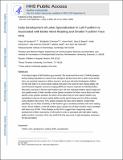| dc.contributor.author | Centanni, Tracy M | |
| dc.contributor.author | Norton, Elizabeth | |
| dc.contributor.author | Park, Anne T | |
| dc.contributor.author | Beach, Sara Dawley | |
| dc.contributor.author | Halverson, Kelly | |
| dc.contributor.author | Ozernov-Palchik, Ola | |
| dc.contributor.author | Gaab, Nadine | |
| dc.contributor.author | Gabrieli, John D. E. | |
| dc.date.accessioned | 2020-08-18T21:15:04Z | |
| dc.date.available | 2020-08-18T21:15:04Z | |
| dc.date.issued | 2018-03 | |
| dc.date.submitted | 2017-08 | |
| dc.identifier.issn | 1363-755X | |
| dc.identifier.uri | https://hdl.handle.net/1721.1/126663 | |
| dc.description.abstract | A functional region of left fusiform gyrus termed “the visual word form area” (VWFA) develops during reading acquisition to respond more strongly to printed words than to other visual stimuli. Here, we examined responses to letters among 5- and 6-year-old early kindergarten children (N = 48) with little or no school-based reading instruction who varied in their reading ability. We used functional magnetic resonance imaging (fMRI) to measure responses to individual letters, false fonts, and faces in left and right fusiform gyri. We then evaluated whether signal change and size (spatial extent) of letter-sensitive cortex (greater activation for letters versus faces) and letter-specific cortex (greater activation for letters versus false fonts) in these regions related to (a) standardized measures of word-reading ability and (b) signal change and size of face-sensitive cortex (fusiform face area or FFA; greater activation for faces versus letters). Greater letter specificity, but not letter sensitivity, in left fusiform gyrus correlated positively with word reading scores. Across children, in the left fusiform gyrus, greater size of letter-sensitive cortex correlated with lesser size of FFA. These findings are the first to suggest that in beginning readers, development of letter responsivity in left fusiform cortex is associated with both better reading ability and also a reduction of the size of left FFA that may result in right-hemisphere dominance for face perception. | en_US |
| dc.description.sponsorship | Eunice Kennedy Shriver National Institute of Child Health and Human Development (Grant R01HD067312) | en_US |
| dc.description.sponsorship | National Institutes of Health (Grant R01HD067312) | en_US |
| dc.language.iso | en | |
| dc.publisher | Wiley | en_US |
| dc.relation.isversionof | http://dx.doi.org/10.1111/desc.12658 | en_US |
| dc.rights | Creative Commons Attribution-Noncommercial-Share Alike | en_US |
| dc.rights.uri | http://creativecommons.org/licenses/by-nc-sa/4.0/ | en_US |
| dc.source | PMC | en_US |
| dc.title | Early development of letter specialization in left fusiform is associated with better word reading and smaller fusiform face area | en_US |
| dc.type | Article | en_US |
| dc.identifier.citation | Centanni, Tracy M. et al. "Early development of letter specialization in left fusiform is associated with better word reading and smaller fusiform face area." Developmental Science 21, 5 (March 2018): e12658 © 2018 John Wiley & Sons Ltd | en_US |
| dc.contributor.department | McGovern Institute for Brain Research at MIT | en_US |
| dc.contributor.department | Massachusetts Institute of Technology. Department of Brain and Cognitive Sciences | en_US |
| dc.relation.journal | Developmental Science | en_US |
| dc.eprint.version | Author's final manuscript | en_US |
| dc.type.uri | http://purl.org/eprint/type/JournalArticle | en_US |
| eprint.status | http://purl.org/eprint/status/PeerReviewed | en_US |
| dc.date.updated | 2019-10-01T14:02:14Z | |
| dspace.date.submission | 2019-10-01T14:02:15Z | |
| mit.journal.volume | 21 | en_US |
| mit.journal.issue | 5 | en_US |
| mit.metadata.status | Complete | |
